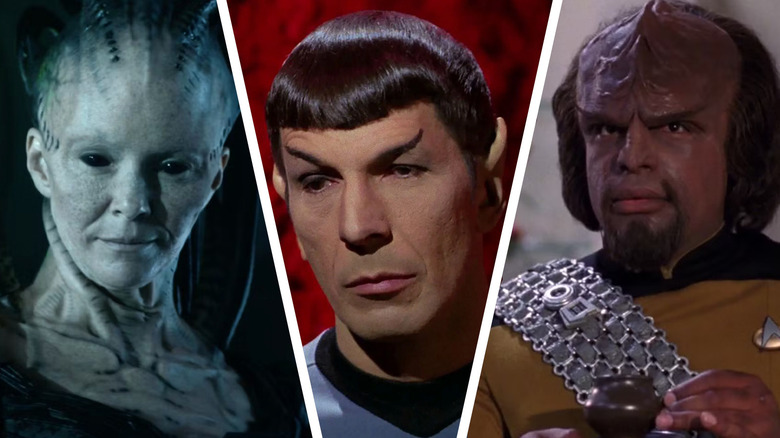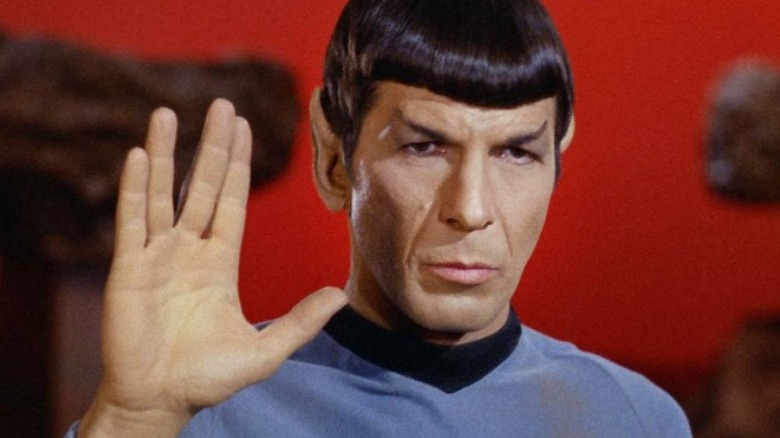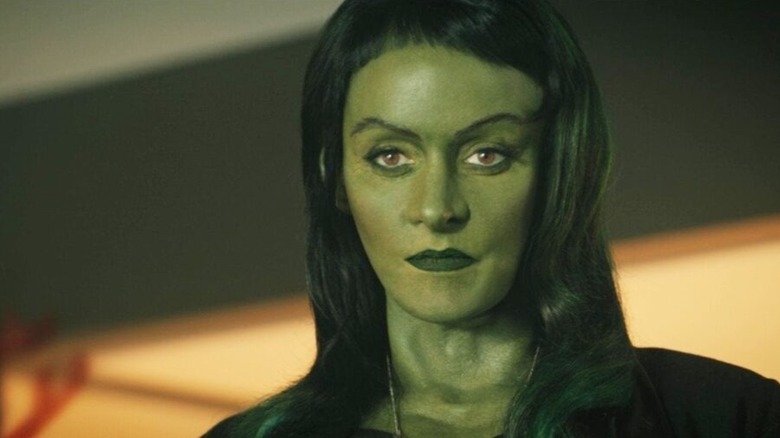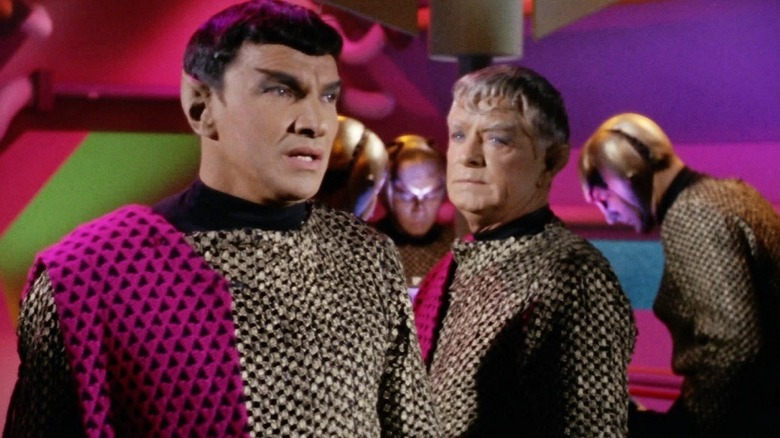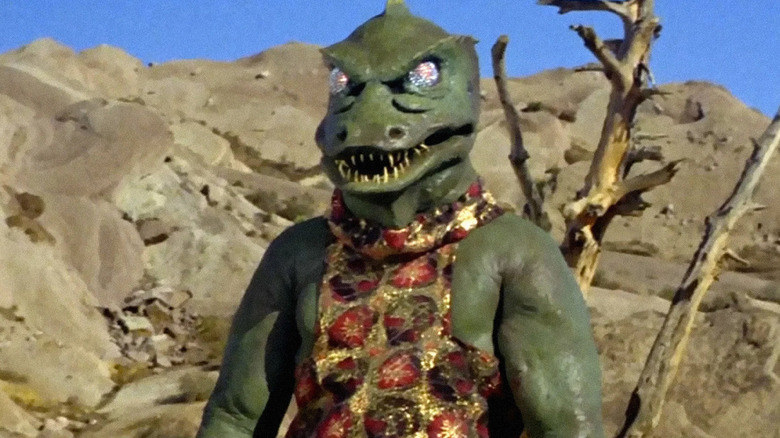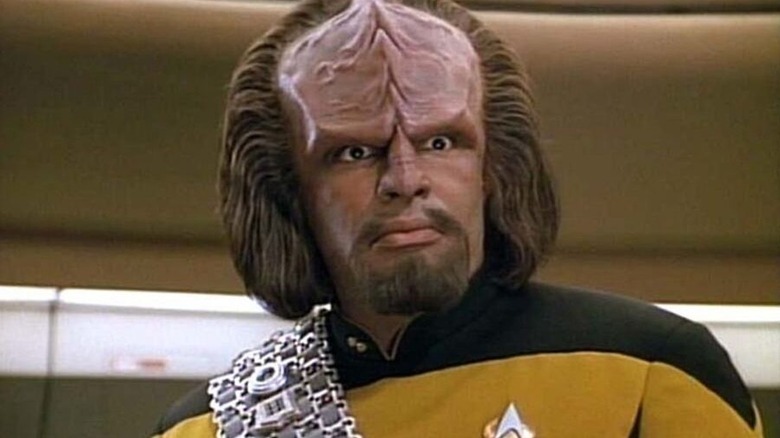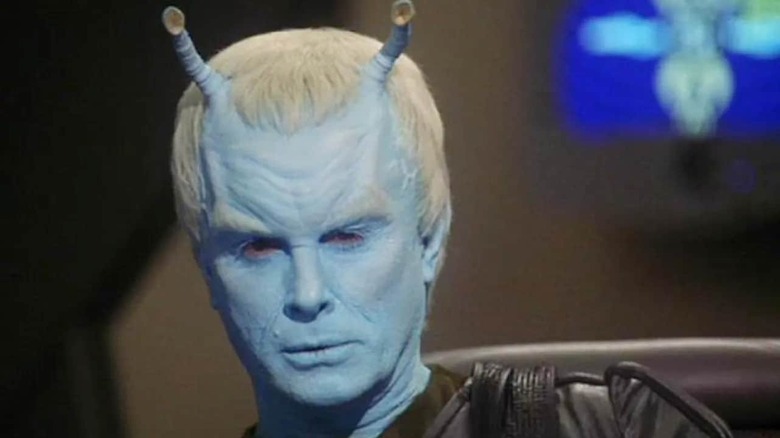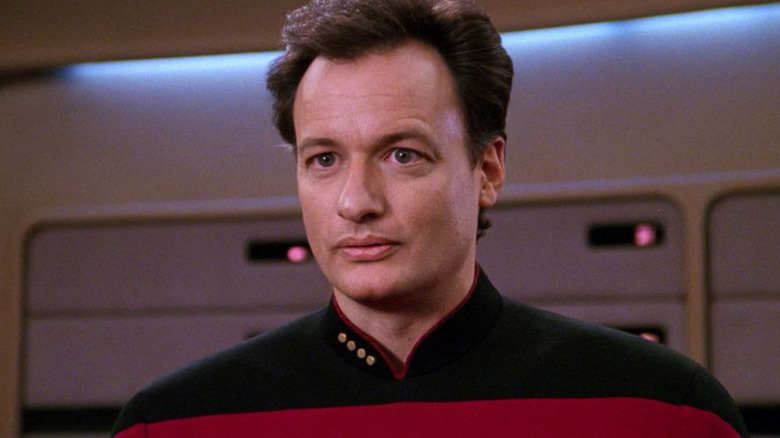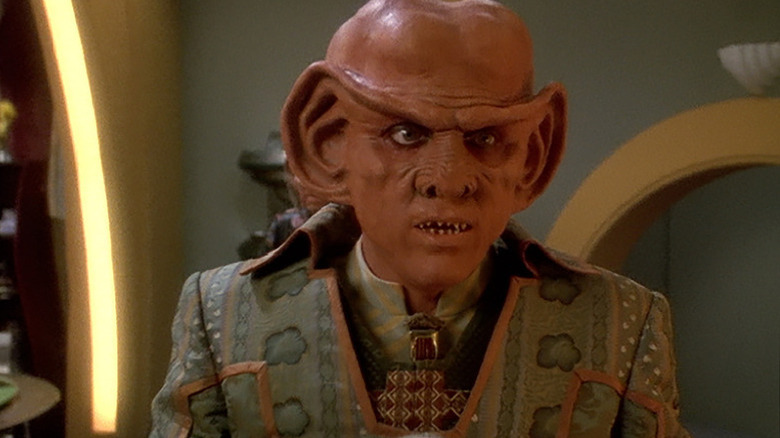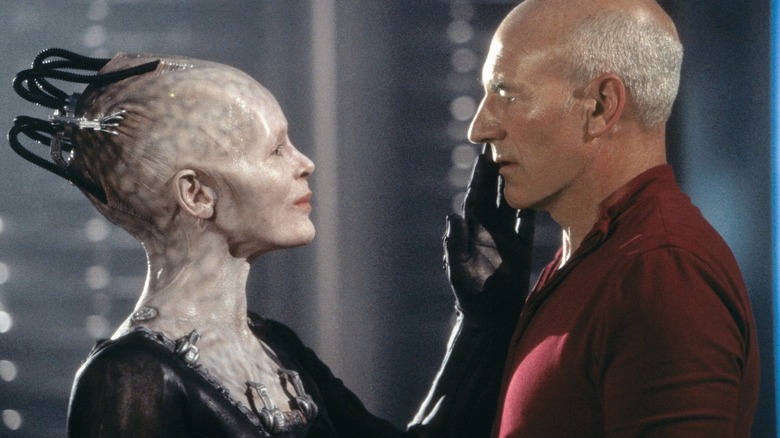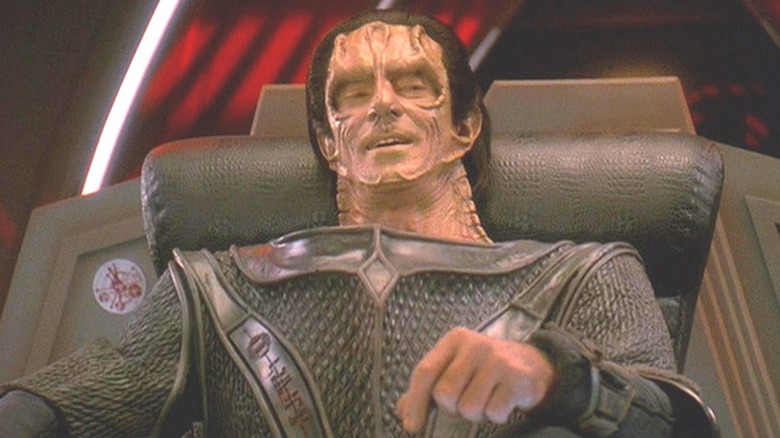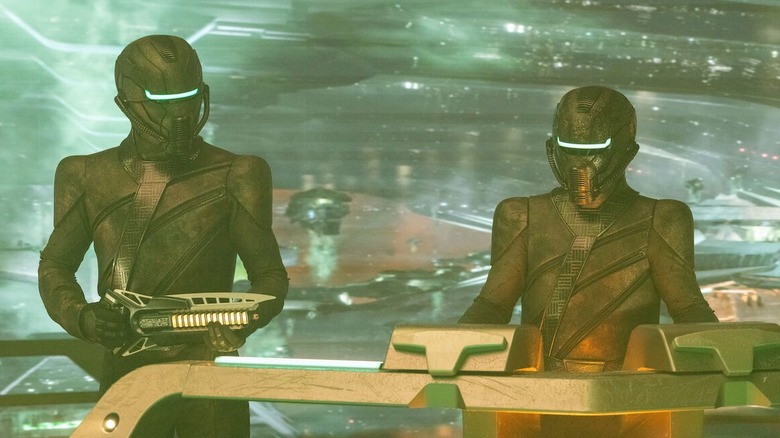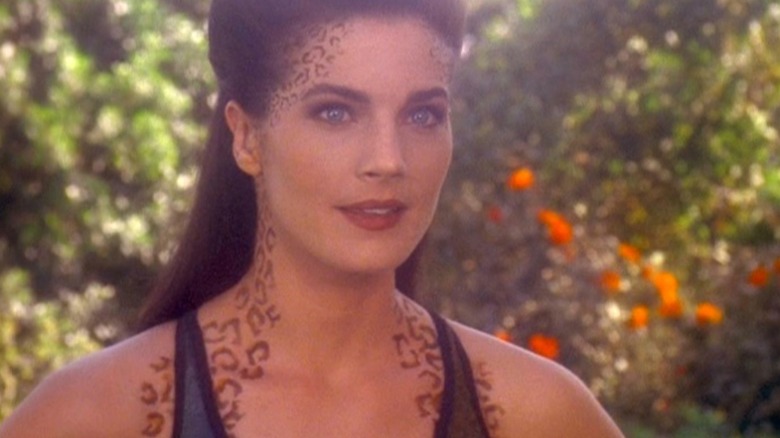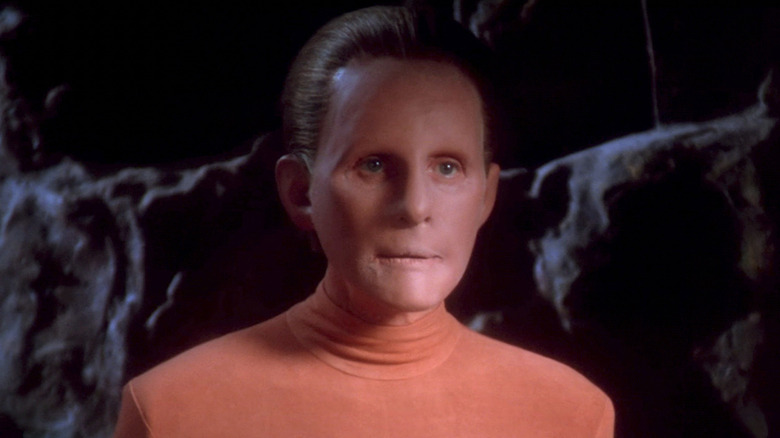The 15 Best Star Trek Alien Races
A staple of the "Star Trek" franchise since its earliest days is its inclusion of imaginative extraterrestrial characters. Whether as members of Starfleet vessels or villains-of-the-week, the memorable presence of alien races is something that happens in every "Star Trek" movie or television series. Over the franchise's legacy, several of these major alien races have undergone substantial revisions, though their core cultures largely remain intact. Decades into its own legacy, "Star Trek" never stops adding new alien civilizations to its growing expansive canon.
Just like favorite characters, everyone has their own personal favorite "Star Trek" aliens that stand above the rest. That said, there are a handful of alien races in the franchise that have become particularly essential and enduring to the "Star Trek" mythos. And then there are other aliens that earned a spot on this list because they're just plain cool. Here are the 15 best "Star Trek" alien races that appeared throughout the franchise's extensive history.
The Vulcans
It's impossible to mention a list of notable "Star Trek" alien races without spotlighting the Vulcans, so let's put them first. The first alien seen in the entire franchise and the breakout character of "The Original Series" was Spock (Leonard Nimoy), the Enterprise's Vulcan first officer. With an outlook and society completely governed by cold, clinical logic, Vulcans can physically be identified by their pointed ears. Vulcans have been a staple in the franchise ever since, bringing an unflappably rational voice to any show or movie as the characters explore the cosmos.
Nimoy developed so many memorable elements of Vulcan culture, including the nerve pinch and the Vulcan salute, which had its own deeper meaning for the actor. Spock's popularity led Nimoy to record an album in character while the stoic science officer became the face of the franchise. Other memorable Vulcans would surface throughout "Star Trek," including the under-appreciated Tuvok (Tim Russ) in "Star Trek: Voyager." Even non-fans can recognize a Vulcan and their mannerisms, underscoring the universal ubiquity that the alien race has enjoyed for decades.
The Orions
The Orions technically predate most alien races in "Star Trek," debuting in "The Original Series" risky original pilot episode "The Cage." Notable for their green skin, initial Orion appearances have them either as seductive dancers or trying to carry out assassination missions. The animated series "Star Trek: Lower Decks" finally shined a light on the Orions, revealing them to be a matriarchal society known for their illicit activities. This notoriety continued into the 32nd century, with the Orion Syndicate being one of the most dominant factions in the galaxy.
Initially depicted as seductresses, assassins, and pirates, the Orions have grown into more a nuanced civilization rather than emerald-tinged villains. It's shows like "Lower Decks" and "Star Trek: Discovery" that added more dimensions to the Orions in very different ways. "Discovery" maintains the adversarial edge to the Orion, while "Lower Decks," particularly through its fan-favorite character D'vana Tendi (Noël Wells) reimagines what the Orions can be in a heroic light. Also a striking sight whenever they appear on-screen, the Orions are always intriguing as either friend or foe.
The Romulans
Before the Klingons, there were the Romulans, the first recurring alien antagonist in "Star Trek," introduced in the episode "Balance of Terror." The Romulans were immediately noted for physically resembling the Vulcans, later revealed to be an offshoot race who settled on the planet Romulus. With a society modeled after the Roman Republic, Romulans use their logical outlook to build a more militant empire, including advanced weapons and aggressive tactics against their neighbors. The Romulans were noticeably redesigned for "Star Trek: The Next Generation," given more pronounced brows and jagged facial features, while retaining their usual pointed ears.
The Romulans had initially been explored with more depth than the Klingons, memorably with an undercover mission during the third season of "The Original Series." This was followed by significant appearances in "Star Trek: The Next Generation" and "Deep Space Nine." When the franchise was revived by the creation of the Kelvin Timeline, it was the Romulans responsible for this temporal divergence. The Romulans have a long history and place in the "Star Trek" universe, one that continues to inform the franchise in both movies and television.
The Gorn
The Gorn are a species that really showcases how much "Star Trek" has evolved since its earliest days. Introduced in the "Original Series" episode "Arena," the Gorn attacked Federation outposts that they felt were encroaching in their territory. Decades later, "Star Trek: Strange New Worlds" retconned the Gorn significantly, making them feel like sci-fi horror villains. In addition to their overpowered warships, the Gorn were more nimble, feral, and had the new grotesque ability to lay eggs in their prey.
The first on-screen Gorn was a literal man in a rubber suit, campily hissing and lumbering slowly like the overgrown lizard it was. A crude CGI Gorn was included in the "Star Trek: Enterprise" episode "In a Mirror, Darkly Part II," retaining its basic design but depicted as being more physically formidable. But it was "Strange New Worlds" that truly made the Gorn the stuff of nightmares, a far cry from their goofy debut. "Star Trek" has always changed with the times, and that evolution can clearly be seen demonstrated in the Gorn.
The Klingons
While the Romulans may have been the first recurring antagonistic alien race in "Star Trek," they were quickly overshadowed by the Klingons, who were introduced 12 episodes later. The Klingons' physical appearance has been altered drastically throughout the franchise, initially appearing as bushy-haired and bronze-skinned individuals before having their brow become more pronounced and ridged. "Star Trek: The Next Generation" redefined the Klingons as having a distinct language and strict code of honor while establishing the Klingon Empire as a confederacy of houses.
One of the boldest things "Star Trek" ever did was put a Klingon on the bridge of the Enterprise showcasing how much "TNG" progressed since "TOS." At the same time, the show wisely maintained the tension between the Federation and the Klingons, something that grew more delightfully complex in "TNG" and "Deep Space Nine." Instilling a bushido-style cornerstone to Klingon culture made them more fascinating than the one-note villains in "TOS" and positioned them uniquely in the franchise. While Vulcans may be the breakout alien race, it was the Klingons that showed how deep and nuanced "Star Trek" could be.
The Andorians
The Andorians have been around for as long as "Star Trek: The Original Series," but it wasn't until decades later that the franchise came up with interesting material for them. The prequel series "Star Trek: Enterprise" revealed that Andorians were among the first intelligent alien species encountered by humanity. Despite an initially contentious dynamic, the Andorians become a key ally in helping Earth defend itself during the Xindi War. By the end of "Enterprise," the Andorians stand as one of the founding members of the United Federation of Planets, cementing their place in franchise history.
From presumed enemies to old Federation allies, the Andorians are an underrated staple in "Star Trek." Immediately recognizable by their blue skin, white hair, and prominent dual cranial antennae, Andorians have at least made a small appearance in virtually every major "Star Trek" series. The heightened profile in "Enterprise" unveiled the Andorians as a militaristic society, complete with its own strict code of honor. Chronologically, the first antagonistic force facing humanity in outer space turned close allies, the Andorians hold a special role in the franchise's development.
The Q Continuum
The very first adversary that Jean-Luc Picard (Patrick Stewart) faced as captain of the Enterprise was the omnipotent Q (John De Lancie). Introduced in the "Star Trek: The Next Generation" series premiere, Q found humanity too barbaric to justify its continued existence. Picard serves as a representative for his species, demonstrating how far humanity had come to a discerning Q, deserving of its chance to endure. Later appearances revealed Q was part of a race known as the Q Continuum, with "Star Trek: Strange New Worlds" confirming a fan theory regarding a classic villain's Q connection.
With the casually reality-shifting powers that Q is capable of, he provides the franchise with its most creatively off-the-wall possibilities. But for as much as Q annoys Picard, the two form an unlikely friendship over their time together, something that reaches an emotional culmination in "Star Trek: Picard." That said, the less the audience knows about the Q Continuum, the better, with the additionally introduced Qs diluting the intrigue around them. Q has some of the best moments in the franchise and the smug cosmic god wouldn't have it any other way.
The Ferengi
The Ferengi were one of the first recurring alien enemies introduced in "Star Trek: The Next Generation," though they never quite seemed menacing enough. It wasn't until "Star Trek: Deep Space Nine" including a prominent contingent of Ferengi characters in its main cast that the species really cemented itself into the franchise. Driven entirely by a love of monetary profit, the Ferengi are governed by strict rules of acquisition enforced by their leader, the Grand Nagus. Physically, the Ferengi are bald, shorter in stature, and possess sharpened teeth and pronounced ears that take up most of the sides to their faces.
A lot of the Ferengi's appeal comes from actor Armin Shimerman, whose character Quark wiped out past Ferengi portrayals. No longer the grating goofballs as they appeared in "The Next Generation," the Ferengi expanded from comic relief to have their own nuanced stories in "Deep Space Nine." The Ferengi went on to have some of the best episodes in "Deep Space Nine," unveiling more about their culture and Quark's increasingly important place in it. Proof that first impressions aren't everything, the Ferengi have enjoyed becoming a firm fixture in "Star Trek" after their uneven introduction.
The El-Aurians
The El-Aurians are a long-standing alien presence in "Star Trek" that still has a noticeable sense of mystery around them. Initially, the only individual from the El-Aurian race introduced was Guinan (Whoopi Goldberg), who was introduced as the Enterprise-D's bartender in the second season of "Star Trek: The Next Generation." Often providing sage wisdom to the crew, Guinan was revealed to have an antagonistic history with Q, though the specifics are never quite elaborated. Hints at Guinan's past have surfaced since, including her history with Earth as early as the 19th century, and that her race was nearly wiped out by the Borg Collective.
Nominally appearing completely human, El-Aurians have a significantly extended lifespan, staying in the physical prime of their lives for centuries. As part of her background, Guinan has potential that has given even the omnipotent Q pause, while also possessing a cosmic awareness that lets her detect temporal anomalies. And yet, for as long as Guinan has been a part of "Star Trek," there is still so little known about the El-Aurians, heightening the intrigue about them. A character that completely changed "The Next Generation," Guinan and the El-Aurians are the last great "Star Trek" mystery waiting to be solved.
The Borg Collective
Arguably the most memorable villainous alien race in "Star Trek," the Borg Collective forever altered the franchise's scope and tone. Debuting in the second season of "Star Trek: The Next Generation," the Borg is a techno-organic race that grows by forcibly assimilating others into its collective. This hive mind is ruled by a singular queen (Alice Krige), with the Borg rapidly adapting to any threat they face. Since their introduction, the Borg have put Earth on the verge of complete assimilation on no less than three occasions, including temporarily assimilating Picard himself.
Whenever the Borg appear, it's all hands-on deck as no threat to the Federation has proven so overwhelming. The franchise has experimented with more nuanced takes on the Borg over the years, including splinter factions and different individuals leading them, but it never quite takes. At their core, the Borg work best as cold, clinical enemies that simply want to assimilate all organic life into their collective. The defining villain of the "TNG" era, the Borg Collective's impact continues to hang over the franchise 30 years after their debut.
The Cardassian
The Cardassian Union was an antagonistic alien civilization introduced in the fourth season of "Star Trek: The Next Generation." More communicative and conniving than the cold and calculating Borg, the Cardassians contested territory with the Federation while using under-handed means to prepare for war. The Cardassians went on to have a significant villainous presence in "Star Trek: Deep Space Nine," vying to retake control of the titular space station. When "DS9" escalated into its overarching Dominion War storyline, the Cardassians were at the forefront of the conflict against the Federation and its allies.
With a reptilian design, including a bony head, scaly skin, and pronounced neck, the Cardassians are a visibly distinct alien race. Marc Alaimo, who played the fan-favorite Cardassian villain Gul Dukat, had his physical attributes determine the look of the entire race. As a society, the Cardassians are brutal, despotic, and unafraid of getting their hands dirty to get what they want, but also are among the Federation's most cunning enemies. "Deep Space Nine" is regarded by some as the greatest "Star Trek" of them all, and the Cardassians are a major factor in that appeal.
The Breen
Like the Cardassians, the Breen are an antagonistic alien race introduced late in "Star Trek: The Next Generation," only to play a bigger role in "Star Trek: Deep Space Nine." In the later series, the Breen Confederacy ally with the Dominion during the Dominion War, providing valuable reinforcements and military technology against the Federation's alliance. The Breen's participation in the war effort is so substantial that they launch a devastating attack on Earth before being pushed back. The alien civilization returns in "Star Trek: Discovery" finally unmasked, with the show making the Breen scary again as they menace the reformed Federation.
The Breen typically are seen wearing containment suits, including a pronounced helmet, and are normally a physically fluid form, but can solidify into green-skinned humanoids. "Discovery" reveals that Breen society is divided into houses headed by primarchs in support, or opposition to, an accepted royal family. The race's striking design and menacing appearance struck a chord with "Star Trek: Lower Decks" creator Mike McMahan, who brought the Breen back to "Star Trek" in his animated series. An intimidating force with a surprisingly extensive reach in terms of different shows they appeared in, the Breen are an underrated villainous presence in "Star Trek."
The Trill
The fourth season of "Star Trek: The Next Generation" introduced the Trill, a symbiotic species that lives within a host's body. This was expanded upon in "Star Trek: Deep Space Nine" with the Trill main character Jadzia Dax (Terry Farrell), the eighth host of the Dax symbiont. Trill symbiont hosts retain their own personalities while inheriting the memories and personalities of previous symbiont hosts. "Star Trek: Discovery" would expand Trill culture significantly through the inclusion of Discovery engineer Adira Tal (Blu del Barrio), the latest host of the Tal symbiont.
The Trill are one of the more unique alien races in "Star Trek," nominally appearing human, save the occasional appearance of prominent skin spots, but serving as a merged lifeform. This symbiosis gave Jadzia a variety of interesting directions, reuniting with old Klingon comrades or experiencing the return of a murderous Dax host. The Trill bring multiple lifetimes of experience to the table per symbiont, something that really makes for rich characters. An alien race that still only feels like the surface has been scratched on for their storytelling potential, the Trill are a welcome and underutilized addition to the franchise.
The Bajorans
The Bajorans are one of the most under-appreciated alien races prominently featured in "Star Trek." The first Bajoran to debut on-screen was Ro Laren (Michelle Forbes), a defiant Starfleet officer assigned to the Enterprise in the fifth season of "Star Trek: The Next Generation." The Bajorans recently liberated their planet from a brutal Cardassian occupation, a development that plays a heavy role in "Star Trek: Deep Space Nine." This included the presence of Bajoran officer Kira Nerys (Nana Visitor) on "DS9," who rose to the rank of commanding officer by the series' end.
Nominally, the most distinguishing feature about Bajorans is their ridged nose and brow, along with the traditionally ornate earrings they often wear. But despite these superficial physical differences, the franchise really delves into and defines Bajoran culture, including religious practices, in a way few "Star Trek" races experience. Through their painful history with the Cardassians, the Bajorans also bring themes around extremism and complex reconciliation to the forefront of the franchise. With such a fundamental connection to "Deep Space Nine" and its deeper themes, the Bajorans deserve more credit for their overall influence on the "Star Trek" universe.
The Changelings
The interstellar Dominion War, which pushed the Federation to the brink of annihilation in "Star Trek: Deep Space Nine," was orchestrated by the shape-shifting Changelings. Originally from the galaxy's Gamma Quadrant, the first Changeling ever introduced was DS9's chief constable Odo (René Auberjonois). Changelings are capable of altering their physical form into virtually any solid or liquid object, including disguising themselves as non-Changelings. This feature makes them an especially insidious enemy when the Changelings team up with the Borg in the final season of "Star Trek: Picard."
The Changelings are a shadowy presence for much of "Deep Space Nine," given that Odo can't initially recall his own origins. This makes them all the more intimidating at the onset of the Dominion War, with the species' cold observations and deceptions outwitting Federation strategies. With the Changelings' return in "Picard," their knack for duplicity leads to several memorable cameos and twists as they infiltrate Starfleet. An antagonistic presence perfectly suited to keep the heroes, and audiences, guessing, the Changelings elevate the threat whenever they're involved.
